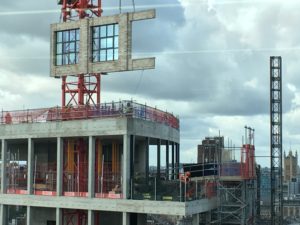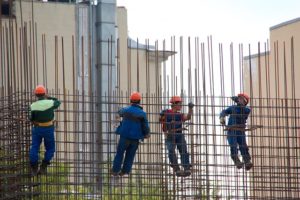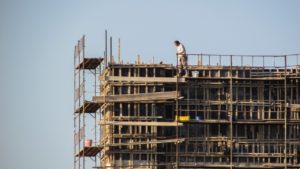Working at Height
‘There are many factors we have to overcome to keep the user safe’: SFS Fall Protection’s James Gooder
SHP recently spoke with James Gooder, Business Manager at SFS Fall Protection about the dangers of working at height, and the importance of horizontal life-line systems.
 SFS is the company behind the fall arrest and work restraint solution Soter II, which allows users to safely work at height without restrictions to their movement, and significantly reduces damage to the roof in the event of a fall.
SFS is the company behind the fall arrest and work restraint solution Soter II, which allows users to safely work at height without restrictions to their movement, and significantly reduces damage to the roof in the event of a fall.
The system allows for up to four users to move freely whilst connected to the line, without the need to disconnect from the system and compromise their safety in any way.
Additionally, users can gain access and egress anywhere along the system and avoid the need for expensive entry/exit terminals.
SHP: Why is it important for employers to take an issue like fall protection/horizontal life-line systems seriously?
James Gooder: “Any building in the UK where working at height is required immediately puts any worker at risk from potential falls. There are CDM (Construction Design and Management) regulations, which govern any new build and state if it has guttering and needs servicing, then it must have a life line system installed. But that’s only about 50% of the market. The other half is the retrofit market.
“Working from height directives will tell you there is a hierarchy involved with working from heights. The first thing the directives say is don’t work at height, but the next stage always says if you do have to work at height, only work with a restraint system. A restraint system is a pre-determined route around the roof. We would recommend a system that is set up approximately two-and-a-half metres from the edge of the building, so an operator would access the roof from a pre-determined access point. Then they would immediately attach a life-line system where they could only follow the route of the life line all the way round the roof until they were back to the access point again. They would never find themselves in a position where they could be involved in a fall.
“The third part of the hierarchy is an arrest scenario, where working from height is required, but the route and the access to the route cannot be pre-determined. These are more a lot more complicated to calculate and require more input from our technical team.”
SHP: What do new building standards and materials mean for working-from-height systems?
 James Gooder: “Life-line systems are attaching themselves to thinner and thinner metal sheeting. We are working with thinner materials. It’s got to the point where life line systems are there to almost save the roof, and the lanyard and the PPE the user wears is there to save them. We have designed into our system shock-absorbing elements to reduce the shock of the fall to the user of below six kilonewtons. Above six kilonewtons, medial opinion states an individual will suffer from soft tissue and organ failure, so we have to keep the force below six. There are many factors we have to overcome to keep the user safe.”
James Gooder: “Life-line systems are attaching themselves to thinner and thinner metal sheeting. We are working with thinner materials. It’s got to the point where life line systems are there to almost save the roof, and the lanyard and the PPE the user wears is there to save them. We have designed into our system shock-absorbing elements to reduce the shock of the fall to the user of below six kilonewtons. Above six kilonewtons, medial opinion states an individual will suffer from soft tissue and organ failure, so we have to keep the force below six. There are many factors we have to overcome to keep the user safe.”
SHP: Are working from height standards improving in this country?
James Gooder: “Our products are designed and manufactured in Yorkshire, but are exported across the world. Around the world, people are starting to ask ‘why in the UK are they giving such importance to working at height, and why aren’t we?’ In fact, we have just been audited by a Russian institute. Other countries are starting to recognise the importance of this now and we in the UK are leading the way with the research and development of these systems.”
SHP: When you put these systems together, do you have to take into account other PPE systems or devices?
James Gooder: “You have a three-minute window when someone falls off a roof. Our concern is that people may rely on that as an opportunity to go and do someone else. That doesn’t mean putting smart systems in place to support the use of these life-line systems is not important. We are looking at the development of integrated devices to work in conjunction with our systems, but these will be related to maintenance and accidental deployment, due to other contractors being on the roof. So, we’re interested in smart developments, but we don’t want people to move to them as an excuse for not putting other systems in place.”
SHP: Do you think the industry kept up with the times and properly innovated?
 James Gooder: “Taking a more holistic view of the marketplace, some of the major PPE manufacturers are taking a greater interest in life-line solutions, as part of their overall offering. They recognise that these specialist solutions work hand-in-hand. I think the PPE market is worth more than £300 million and some of the innovations, like grab locks are keeping up to pace with life-line systems.”
James Gooder: “Taking a more holistic view of the marketplace, some of the major PPE manufacturers are taking a greater interest in life-line solutions, as part of their overall offering. They recognise that these specialist solutions work hand-in-hand. I think the PPE market is worth more than £300 million and some of the innovations, like grab locks are keeping up to pace with life-line systems.”
SHP: Do you think there needs to be more steer from the Government in terms of regulations?
James Gooder: “There are various steering groups out there. They work hand-in-hand with the construction industry. There is a new standard in draft at the moment – EN17235 – which is trying to pull together companies that manufacture systems for roofing and safety systems, so it can be shown that they have worked together to develop solutions that work with every type of roof construction. We take a view, like a lot of our peers, that you have to test a system on different panels, but the new standard says that is not enough; you need to say which panels you are going to test on, prove it and then you will be allowed to sell products to be installed on it. These standards have been in draft for a few years, but we can see the steering groups are keeping an eye on the pace of change for new materials, so elements of chance and elements of doubt are removed.”
‘There are many factors we have to overcome to keep the user safe’: SFS Fall Protection’s James Gooder
SHP recently spoke with James Gooder, Business Manager at SFS Fall Protection about the dangers of working at height, and the importance of horizontal life-line systems.
Jamie Hailstone
SHP - Health and Safety News, Legislation, PPE, CPD and Resources Related Topics
Gogglebox star George Gilbey died after fall through skylight
Company fined after worker fractures skull
Work at height charity launches ‘No Falls Week’

 SFS is the company behind the fall arrest and work restraint solution Soter II, which allows users to safely
SFS is the company behind the fall arrest and work restraint solution Soter II, which allows users to safely  James Gooder: “Life-line systems are attaching themselves to thinner and thinner metal sheeting. We are working with thinner materials. It’s got to the point where life line systems are there to almost save the roof, and the lanyard and the
James Gooder: “Life-line systems are attaching themselves to thinner and thinner metal sheeting. We are working with thinner materials. It’s got to the point where life line systems are there to almost save the roof, and the lanyard and the  James Gooder: “Taking a more holistic view of the marketplace, some of the major PPE manufacturers are taking a greater interest in life-line solutions, as part of their overall offering. They recognise that these specialist solutions work hand-in-hand. I think the PPE market is worth more than £300 million and some of the innovations, like grab locks are keeping up to pace with life-line systems.”
James Gooder: “Taking a more holistic view of the marketplace, some of the major PPE manufacturers are taking a greater interest in life-line solutions, as part of their overall offering. They recognise that these specialist solutions work hand-in-hand. I think the PPE market is worth more than £300 million and some of the innovations, like grab locks are keeping up to pace with life-line systems.”